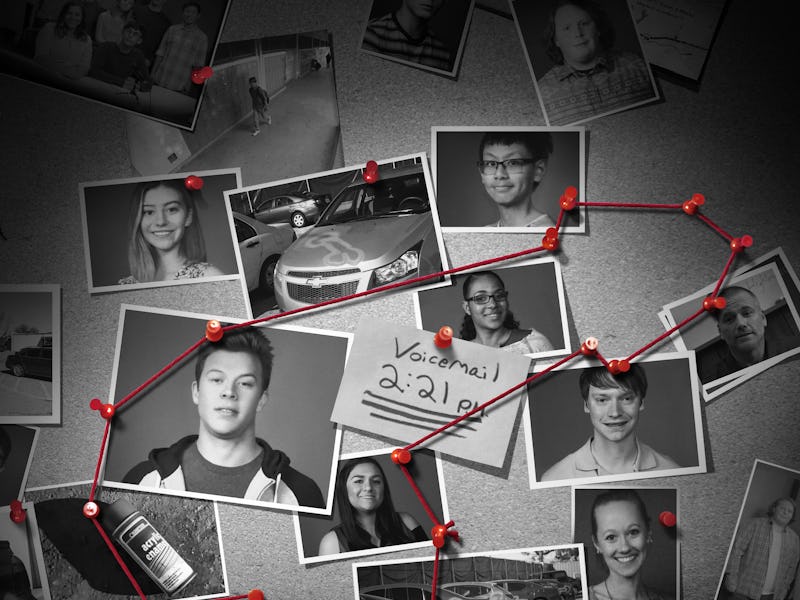Don't End 2017 Without Watching 'American Vandal'
The best show on Netflix, and of the year, still awaits.

I didn’t see it coming. I was caught by surprise. This was the true twist awaiting me during my post-Thanksgiving binge of American Vandal. Three hours deep, I asked myself with stone cold seriousness and not a hint of irony: “Who really drew the dicks?” That’s when I understood the power of American Vandal, a show I confidently consider to be a modern classic.
Let this be your final warning before the year is over: You need to watch American Vandal. Stop whatever else it is you’re watching, even if it’s The Crown or The Good Place. Watch American Vandal. At eight episodes and a breezy 48-ish minutes apiece, you can start and finish 2017’s best show in one emotional roller coaster ride. You’ll be happy you did.
A scripted comedy masked as an eight-part “documentary,” American Vandal, from showrunners Dan Perrault and Tony Yacenda, spoofs trendy true crime programs like Making a Murderer and The Keepers (also big Netflix hits, which can’t be a coincidence) by sending up the tropes of the genre while offering pointed commentary at the awfully invasive way media penetrates the lives of young people. It’s brutally funny as it is brutally emotional. But the true genius of the show isn’t its postmodern satire, where half-baked jokes are presented with polish to resemble an Emmy contender. If American Vandal was good, it would stop there. But American Vandal is so much more.
Tyler Alvarez and Jimmy Tatro star in 'American Vandal' on Netflix.
Set in a California high school, American Vandal follows Dylan Maxwell (YouTube star Jimmy Tatro), an orcish bully accused of spray painting 27 cars with hairless penises in the parking lot. Tyler Alvarez, whose mouth breathing is an art form, plays Peter Maldonaldo, a wormy student in the AV club who covers Dylan’s case through a documentary where bad football tryouts, texts with “heyy” (two Ys), and sleep-away camp handjobs are evidence. Halfway through, Peter’s documentary goes viral, making Peter’s sacrifices to finish his movie feel just as urgent as proving Dylan’s innocence before graduation. All the while, the guilty party hides in plain sight, hidden until the end — maybe.
At first glance, American Vandal looks like it lacks steam. It has a premise that could only work in bursts, such as within the confines of a Saturday Night Live short. There’s no way it can fill eight hours on Netflix. Marvel could barely keep anyone’s attention with 13 hours of Iron Fist, so how could American Vandal? Well. Vandal does two things that make it work.
The first is that “penis graffiti” isn’t a horrendous crime, like murder. (Something SNL would have done.) Rather, it’s the cost, $20,000+ in damages, that gives weight to Dylan’s fate. Through the lens of a documentary, Dylan — who in an ‘80s teen movie would get his comeuppance — is fleshed out as a person, who has finally understood the consequences of his foolishness at the worst time. By the time you pity him, it’s too late. Dylan lacks the resources, security net of a decent family, and just the plain legalese to defend himself. All Dylan can do is watch Judge Judy and say “I didn’t do it, ma,” and he’s powerless to prove it.
'Vandal' has the liveliest portrayal of modern American high schools than any show in recent memory. But it's how it destroys that world too is what gives the show weight.
The second praise the show rightfully deserves is its portrayal of modern teenagers, who have more dimensions than AP geometry. While watching the show, I was overwhelmed with memories of my own years languishing in homeroom, something no CW show has ever achieved. And unlike John Hughes movies, the kids in Vandal are diverse, not just racially but archetypically; the “hot girl” isn’t an airhead, the nerdy kids aren’t altruistic heroes, and Dylan has flashes of decency. He farts on babies, yes, but he doesn’t want to hurt anyone. He has hopes and dreams, and a girlfriend he wants to do right by. A full life awaits Dylan, his obsession with dick graffiti nothing more than a phase of restless adolescence. Now, it may enough to ruin everything.
You'll never be more interested in dick doodles than in 'American Vandal.'
In a pop culture landscape dominated by shallow, even vengeful teenagers like in Riverdale, the teens of American Vandal feel alive as if they still exist even after you’ve switched off Netflix. Faced with modern problems that speak timeless truths about growing up, American Vandal is perhaps the best portrayal of what it means to be a teenager in a generation. Maybe even you were a Hanover High student, once upon a time.
So it means something when their lives are changed by Peter’s documentary. Peter pours over social media for evidence and guerilla shoots interviews with his iPhone. So when Peter’s documentary, the show-within-the show, goes viral, the candid moments and evidence-gathering caught on camera attracts the attention of the world. What’s it like when your “list” of hook-ups, collected as evidence for no reason, are revealed to the world? It sucks. It really, truly sucks.
There are absolutely flaws to American Vandal, but right now I can’t think of them. All I can think about is one specific scene. At one point, Peter’s best friend and co-director, whose friendship almost disintegrates during shooting, tells Peter to stop recording because they’ll be suspended if they’re caught filming. Peter tells him he can’t. After eight hours, I really believed him.
American Vandal is streaming now on Netflix.